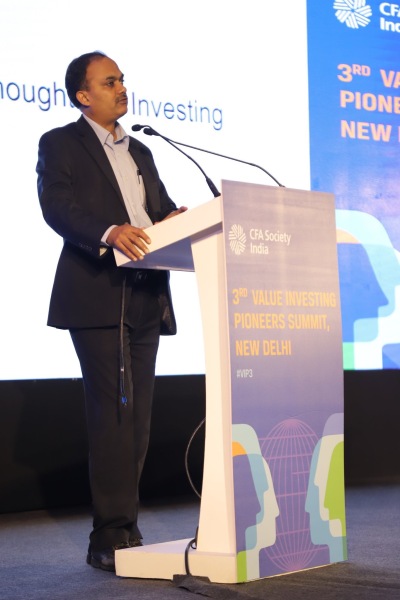- November 29, 2019
- Posted by: Shivani Chopra, CFA
- Category:BLOG, Events

Speaker: Prashant Jain, CIO, HDFC AMC
Moderator: Rajeev Thakkar, CIO & Director, PPFAS Mutual Funds
Contributed by : Udai Cheema
Star-studded event with a high impact factor!
Last year, I had attended the 2nd Value Investing Pioneers Summit. That event was quite a learning experience for me, so when the opportunity presented itself again this November, I was there. After all, who can resist this line up of speakers, take a look-

We are talking about 100+ years of cumulative market experience along with assets under management worth billions of dollars. So, not wanting to miss out on such a golden opportunity, hundreds of participants thronged the halls of Hotel Pullman, Delhi Aerocity on the 8th of November 2019 for the 3rd Value Investing Pioneers Summit.
Here are some of the key takeaways from the first session of the conference –
- Regardless of many gloom and doom scenarios locally or globally over the last four decades, India has maintained a nearly constant nominal GDP growth. He gave a great analogy to explain the importance of that fact-“We are sitting in a boat that is in a river flowing at a steady speed and if we don’t mess up then the river itself will create significant wealth for us”.
- First time in the history of India, the inflation rates have stayed at the level of 4-5% over a prolonged period of nearly 5 years. If this is an indicator of things to come then we might have to lower our expectations of market returns going ahead.
- Most of the economic parameters are currently in India’s favor such as inflation, current account deficit, foreign exchange reserves, interest rates but ironically the growth has slowed down sharply due to lower discretionary consumption.
- The main reason for the consumption slowdown in his opinion is that the white-collar wages in India have de-grown in real terms and over the years there has been a convergence in the average wage of white-collar and blue-collar jobs in India. As a result, the financial savings rate in India has also fallen for the first time in the last ten years. A big chunk of the consumption that has happened in the last couple of years has actually been debt-fueled consumption on the back of EMIs. There is a limit to how much borrowing a society can do, that limit might have been reached in India causing the overall slowdown in the economy.
- In fact, in the 80s India’s per capita income was higher than China but now it is 5 times more than ours. Same is true for wages, wages in China are much higher than those in India. On the other hand, this along with factors such as US-China trade wars and environmental concerns in China have also led to the shifting of global manufacturing base from China to other Southeast Asian countries such as Vietnam, Thailand, Indonesia whereas India was missing out due to higher corporate tax rates but going forward that is no longer a worry as the government has cut corporate tax rates bringing them at par with global averages. A massive domestic market and ample workforce give India an added advantage over these countries.
- India’s market cap to GDP ratio indicates that there is good value in the market at present. When earning yields converge with bond yields, it means one is paying very little for growth which is the present scenario. With the cost of capital/interest rates moving lower, it will have a positive impact on the earnings going ahead improving yields.
- Simply if we remove some of the consumption-oriented stocks from the equation, there is a lot of value in the markets currently. The forward PE of the index which is roughly 15 times can fall anywhere between 20-30% if we are to remove these names. Consumer staples being traded at 50-100 times is unheard of and more so abroad. Even though the markets continue to defy the logic of value but in the past, all excesses, be it 1992, 2000, 2008 or 2017 were curtailed eventually. Also, remember that whenever the markets are over focused on one area it creates lots of opportunities (value) in other areas, it’s just that long term thinking is required along with patience.
“Keep things simple, one doesn’t always have to write a 100-page report to come to a conclusion. Simply apply the right logic and if you find no flaw in your logic then just stay put till the market eventually corrects itself.”
- Instant gratification and desire to avoid pain are the two factors that contribute to the emergence of value buying opportunities in the markets. To illustrate this he used the famous example of the Marshmellow test.
- Momentum is easy to participate in and difficult to stay away from because if one doesn’t then people appear to be earning today whereas you might not be which can be painful. Another tendency that supports momentum is that people simply extrapolate the present into the future which might not be the case. Instead one needs to understand why the business is doing well or badly over the last couple of years and where the business is headed from here on in. So, buy cheap, increase your understanding of the business over time, keep modifying your views and in the long run, markets are likely to agree with you as they are quite efficient in the long term.
- An interesting hack he mentioned to understand where the exuberance and pessimism stand at the moment is to look at the long term charts of the sectoral indices. On a yearly basis, they will clearly tell you which are the most loved and hated segments of the market. Understand that one cant simply extrapolate the peak earnings of a sector into the future, more so when the earnings have had a boost in recent times due to external ‘one-time’ factors.
“Mean reversion is true in life and in the markets. Both good and bad times shall pass.”
- The discount of PSUs to the market as a whole has deepened quite sharply in recent times as there are some preconceived notions in the market for these public companies. PSUs are very predictable businesses and fairly easy to understand. PSUs are run under strict guidelines and investments in unrelated areas are quite infrequent. The mortality in the PSU space is much lower than in the private sector. In fact, PSUs in their particular sector are quite dominant franchises.
“Not all public sector is bad and not all private sector is good”
- In fact, PSUs are a better paymaster than the private sector as on date which might not have been the case 15 years back.
“A major flaw in our thinking is that we tend to generalize by exceptions”
- The media always highlights the outliers and not the averages. Rather than looking at the average salary of Virat Kohli, one should try to find out the average salary of an average cricketer for the purpose of generalization. The more people start working with averages, they are more likely to reach the right conclusions.
- Amongst the PSUs, service-based companies like the ones in the telecom sector or the airlines’ sector are at a significant disadvantage but the resource-based, asset-based, trust-based companies have significant advantages and value. Simply the dividends in some of these companies are at par or even two times the bond yields at present. Also, the announcement of strategic divestments bodes well for this segment of companies.
- Efforts must be made to try and seek out people who have contrary views on a particular idea. It helps challenge the confirmation bias. Documentation, presenting ideas to peers is a great exercise for building a strong investment thesis. One must listen to everyone, evaluate the merits of each argument but in the end make your own decisions as your money is your responsibility.
- Information overload is a problem in modern times. Sifting through all that to reach the info/data that truly adds value has become increasingly difficult. So, work only on your high conviction ideas which according to you have the best chance of delivering superior returns rather than looking at everything.
- Investing at an institutional level can never become fully process driven because in the same institution there will always be a duality of opinion that should be encouraged.
“Processes can lead to average outcomes with more certainty but great outcomes in this industry won’t be possible without great individuals.”
- One doesn’t always have to be a contrarian while investing. It is all about understanding the business well, figuring out its fair value and how it will move i.e the key drivers and the risks associated with the business. If you prudently invest after figuring out all of that and it happens to be a contrarian call then so be it.
“There is a thin line between being early and being wrong.”
- In such a scenario, simply go back and see why things have not played out the way you had anticipated. If you find a flaw in your assumptions/thesis then exit regardless of the price but if you still believe that buying the stock was the right call then have patience and simply wait it out before the market realizes its true value.
“If your conclusions are right then it has been frequently observed that the longer the pain period, higher are the rewards.”
- There are very few companies that are exceptional in perpetuity. The companies’ termed as exceptional today weren’t viewed the same way 20-30 years back. So there should be a threshold below which investors must not go but one cant stay restricted to buying only exceptional companies. So one must take an objective and pragmatic view on quality and price.
“We are in the business of investment and not in the business of buying the best companies, we should aim to make good returns on our capital.”
- How to identify a bubble;
“1.When everyone wants to buy the same stock. Consensus trades after a while tend to become a bubble both on the upside and downside but sometimes on the downside, they can turn into value bets.
2.Strong divergence from the past.
3. Think about what has led to the current situation.”
For example, in the consumption stocks, the earnings growth has not been superior compared to the past. The growth stands out because other sectors have hardly shown growth in comparison but on a standalone basis these consumption names have not grown earnings much but the margins have grown sharply. Most of these companies are sitting at lifetime high margins. So, if one was to break up the returns from topline growth and margin expansion, one will get the answer to the future as the margins can only grow so much and what are we paying at present for that.
“Simply try and understand what brought us here and is it sustainable.”
- On the Auto Sector – not sure if the growth is coming back because cars face a challenge of affordability and the two-wheelers market in India has matured. Great value in the sector is not apparent.
- High-interest rates are not the reason for the slowdown in growth. The mortgage rates today are much lower than what they were earlier, so the EMIs have dropped 20-30% but home sales and car sales which should have gone up aren’t doing so. This clearly suggests the issue of affordability as the gap between rental yields and mortgage yields is high in India making the EMI outgo much higher than the collectible rent. As there is a de-growth in the white-collar wages, the real estate has become unaffordable for many which has put the entire real estate sector in jeopardy.








